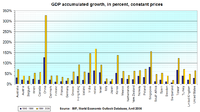
Photo from wikipedia
This study explores the inherent linkage mechanism between environmental pollution and economic growth using a non-linear MS (M)–VAR (p) model. The results indicate that, first, the growth rates of China's… Click to show full abstract
This study explores the inherent linkage mechanism between environmental pollution and economic growth using a non-linear MS (M)–VAR (p) model. The results indicate that, first, the growth rates of China's gross domestic product (GDP) and SO2 emissions are in a state of significant inertia. Second, when the system was in a medium-growth regime, the growth rates of SO2 emissions and GDP had a positive correlation, characterized by lower probability and weaker durability. Third, when the system was in a high- or low-growth regime, their growth rates were negatively correlated, characterized by higher probability and stronger durability. Overall, economic growth increases environmental pollution emissions, which intensifies as well as inhibits economic growth. The correlation and sustainability of SO2 emissions and GDP are closely related to the regional status of the entire system. This study is helpful in analyzing the reasons for the nonlinear linkage mechanism between environmental pollution and economic growth.
Journal Title: Frontiers in Public Health
Year Published: 2022
Link to full text (if available)
Share on Social Media: Sign Up to like & get
recommendations!